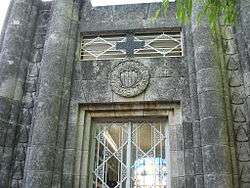Charitable Society of the Natives from Catalonia
 | |
| Founded | 1840[1] |
|---|---|
| Type | NPO, social help, cultural institution |
| Location |
|
Area served | Cuba |
Members | 1,400 |

The Charitable Society of the Natives from Catalonia (Catalan: Societat de Beneficència de Naturals de Catalunya), also known as the Casal Català or the Beneficencia Catalana,[2] is a charity founded by the Catalonian immigrants in Havana, Cuba, in 1840.[3][4]
Overview
The association is considered the oldest social association in the world. It was founded by a group of 102 emigrants from Catalonia, led by Antoni Font and Josep Gener,[3][5] in order to assist Catalans who did not make a lot of money and stranded in the Cuban capital. The association began increasing its membership following the independence of Cuba in 1900. Members of the organization included José Murillo and Joaquim Muntal, who was vice-president from 1925 to 1928.
Its main activity is providing economic support to the members but, with the passing of years, the Catalan Charity has incorporated a welfare function, while also participating in some cultural and festive activities. With more than 1,400 partners, they promote different activities related to Catalonia, including habaneres, the celebration of Sant Jordi, esbart dansaire, puntaires, poetry readings, concerts and film screenings.[1] [5]
Another one of their objectives is the maintenance of the Monserrate hermitage that was planned to be installed in the Square of the Revolution in the last years of the government of Fulgencio Batista, but was finally built on a farm near the Havana airport at the end of the 1950s. The hermitage is a replica of the S'Agaró church and houses a replica of the Virgin of Montserrat.[5]
With over 170 years of history, the association has a legacy of documenting the economic and social conditions of Catalan emigrants, and has received awards from the Institute of Catalan Studies, the Generality of Catalonia and the Cross of St.George 1993.[6]
See also
References
- 1 2 "Independentista a l'Havana" (in Catalan). La Vanguardia. 22 September 2015: 6.
- ↑ Joan Casanovas (15 November 1998). Bread Or Bullets: Urban Labor and Spanish Colonialism in Cuba, 1850–1898. University of Pittsburgh Pre. pp. 54–. ISBN 978-0-8229-7194-8.
- 1 2 Moisés Llordén Miñambres; Fernando Devoto (1995). Acerca de las migraciones centroeuropeas y mediterráneas a Iberoamérica: aspectos sociales y culturales (in Spanish). Universidad de Oviedo. pp. 153–. ISBN 978-84-7468-867-2.
- ↑ Juan Andrés Blanco Rodríguez (2008). El asociacionismo en la emigración española a América (in Spanish). UNED Centro Asoc. de Zamora. pp. 57–58. ISBN 978-84-936871-0-6.
- 1 2 3 Hernández, Óscar (28 June 2015). "Empremta catalana a l'Havana" [Catalan footprint in Havana] (in Catalan). El Periodico de Catalunya. Retrieved 22 September 2015.
- ↑ "Més de 10.000 imatges digitals de La Societat de Beneficència de Naturals de Catalunya a L'Havana ingressen a l'Arxiu Nacional de Catalunya" (in Catalan). Generalitat de Catalunya. 11 June 2015. Retrieved 22 September 2015.
Bibliography
- La Beneficencia catalana de La Habana: 150 años de historia : 1840–1990 : Sociedad de Beneficencia de Naturales de Cataluña. Fòrum solidari. 1999.
- Rodríguez Ortega, Idania Ester (2010). De Cataluña a Cuba... ¡Hacer las Américas! (in Spanish). Grupo de Comunicación Galicia en el mundo.
External links
| Wikimedia Commons has media related to Charitable Society of the Natives from Catalonia. |
- Reglamento Of the Sociedad of Beneficencia of Naturales of Cataluña. printer. M. Soler, 1851.
- «La Sociedad de Beneficencia de Naturales de Cataluña», El blog de los catalanes de Cuba
- Digitalisation of more than 10.000 images of the distribution of socors realised by the entity (1936–1946) deposited to the National File of Catalonia